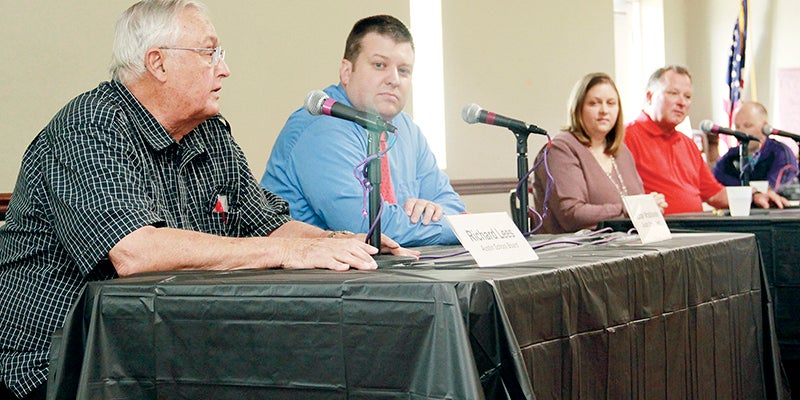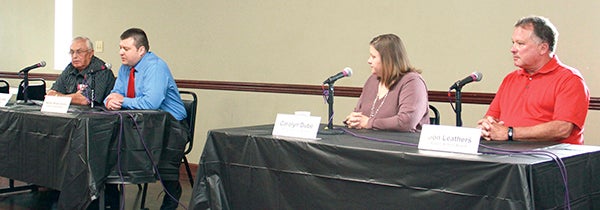School board candidates discuss the issues
Published 6:02 am Monday, September 26, 2016

- Austin Public School Board candidate Richard Lees, Nathan Wradislavsky, Carolyn Dube and Don Leathers participate in a forum hosted by the Austin Area Chamber of Commerce and KAUS Radio at the Austin Eagles Club on Thursday. Jason Schoonover/jason.schoonover@austindailyherald.com
Four candidates for three positions on the Austin Public Schools Board made their cases as to why they’re the best choices to help shape the future for Austin’s children.
Incumbents Richard “Dick” Lees and Don Leathers and newcomers Carolyn Dube and Nathan Wradislavsky discussed several issues facing the district on Thursday during a forum hosted by the Austin Area Chamber of Commerce and KAUS Radio at the Austin Eagles Club.
The candidates
Carolyn Dube is a 1997 Austin High School graduate who taught music for several years, recently completed a doctorate in education leadership and management and works online for Capella University as a curriculum specialist.
“I am running for school board as a person who is really interested in providing our students and kids with a great educational experience,” Dube said.
She said her children look forward to going to school and come home excited about what they’ve learned, and she wants other children to feel the same way.
“I’m really excited about helping other kids have that same experience,” Dube said.
Leathers, a former teacher, was elected to the board in 2012, and he praised the district’s leadership as a big reason he wants to come back for another term, praising their efforts to get the board and everyone working toward a common goal.
“I’d like to have another four-year term to maybe learn some more things, get out into the schools and influence the direction and the course where our district is going,” he said.
Leathers said his favorite part of serving on the school board is getting to check out things like the first day of school and graduation, which he described as the culmination of 13 years of hard work.
Like Dube, Nathan Wradislavsky, an AHS grad, decided to run for school board after being interested for several years because he wanted to help his own children and other children in town.
“I want to be instrumental in shaping the school board for all children in the Austin community,” he said.
Wradislavsky said he wants to make sure all students have an opportunity to have the same educational opportunities.
“I’m excited to have this opportunity to join a great team and work to make the system even better than what it is through teamwork,” Wradislavsky said.
Richard “Dick” Lees has been on the board for many years, and he touted his experience which has covered changes like new schools, curriculum changes and the changing demographics of the district.
“I’m familiar with the curriculum, I’m familiar with the various units,” he said.
Lees praised the board for working well as a unit, which he said isn’t common with all districts, and he praised everyone involved with the schools, from cooks to teachers to parents and beyond and said they all need to know they play a key role in the educational process.

Austin Public School Board candidate Richard Lees, Nathan Wradislavsky, Carolyn Dube and Don Leathers participate in a forum hosted by the Austin Area Chamber of Commerce and KAUS Radio at the Austin Eagles Club on Thursday. Jason Schoonover/jason.schoonover@austindailyherald.com
The issues
Austin’s school calendar continues to be a much-discussed issue after the district formed a calendar committee to investigate alternative start times and calendar options. Though the committee recommended no change earlier this year, the board has talked about revisiting the issue and furthering public education around such options.
Leathers said the 45/15 schedule in place at Sumner Elementary and the adjoining classes at Woodson Kindergarten Center has been successful in helping students retain knowledge by replacing a traditional summer break with shorter, periodic breaks.
However, the calendar options met some resistance due to concerns over extra curricular activities, busing, vacations and the county and state fairs.
“We’re still going to continue to look into 45/15 calendar, and those people that worked on that — just awesome amount of work that they did,” Leathers said.
Dube finds the 45/15 calendar beneficial to student retention, and she referenced studies that show the challenges of retaining knowledge over longer summer breaks.
She’d like to have more discussions about what options will do the most good for the most students.
“Over the next few years, it’d be great to see some further conversations to understand how we could find the best fit for this district,” she said.
Even with the benefits of alternative calendars and the hard work of the calendar committee, Lees noted plan would need wide community support due the potential challenges of such changes.
“This is something the community must buy into,” he said.
“As beneficial as it is to a lot of groups, it has its problems,” he added.
Wradislavsky noted the plan is working well at Sumner, and he noted he sees the summer slide with his own children, but there would be challenges and growing pains to face through the community.
When it comes to student test scores not improving in the district, Wradislavsky noted his children and their friends have questioned if student testing is becoming excessive.
Lees noted test scores take the entire student body. And while the top students are doing very well, Austin faces challenges from having an extremely diverse school system with more than 40 home languages represented across the district.
Dube finding the best approach with a curriculum and having good conversations between administrators, the board and teachers to find the best approach toward improving the curriculum and education.
However, Leathers noted that test scores change frequently so it’s like aiming at a moving target. Leathers credited the district and staff — including support coaches, interventionists and English language learners testers — for helping maximize the potential of Austin’s diverse population.
“Our staff is doing the best it possibly can given the situation,” Leathers said.
When asked about the district’s biggest challenges when looking to the future, all the candidates referenced Austin’s growing diversity in some sense, where Lees spoke of challenges because many students don’t speak English, Wradislavsky said the district must work to include everyone and work together as one community, and Dube agreed noting Austin is a much different community than when she graduated from Austin High School, which will require the district to keep adapting.
Lees also spoke about the need to keep the district’s facilities up to date and in good condition and he also spoke of the need to get teachers to stay in Austin.
Dube said the district must find ways to retain teachers and provide them with the support to educate its students.
But to Leathers, the biggest issue facing the students is poverty as more than 50 percent of the district’s students are on free or reduced lunches, and there are several backpack programs aiming to assist students.
“If you go to bed hungry and you wake up hungry, you’re going to have a heck of a time learning,” Leathers said.
Along with the teacher shortage being another key issue, Leathers also said they need to be mindful of the achievement gap in giving all students an equal chance to succeed.



